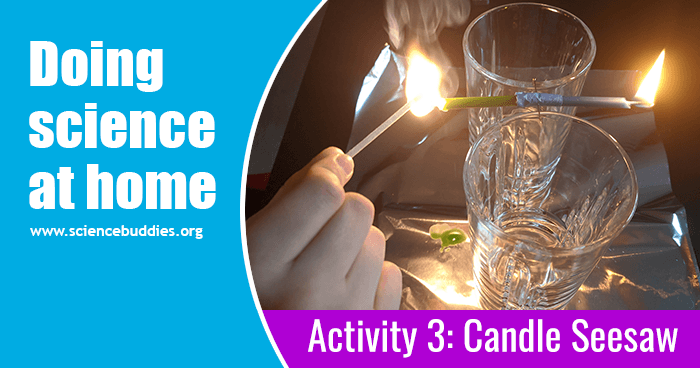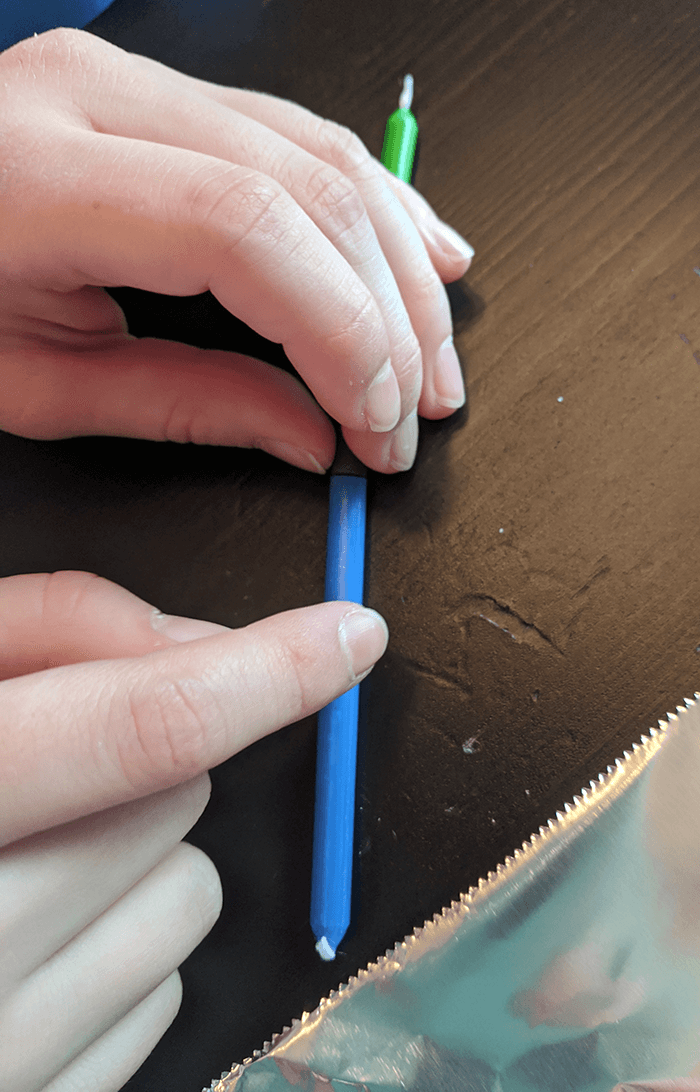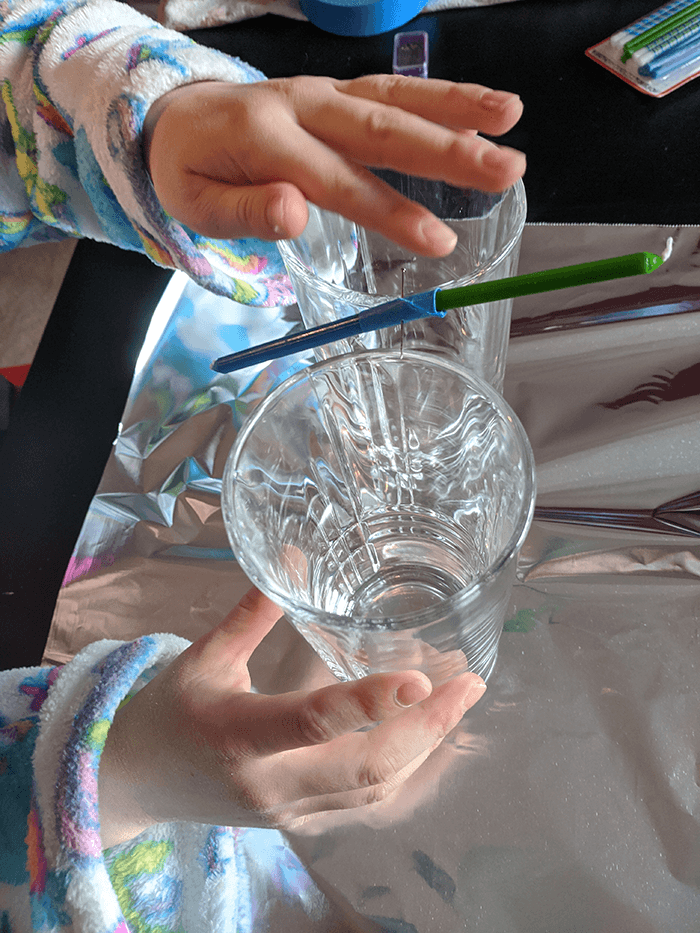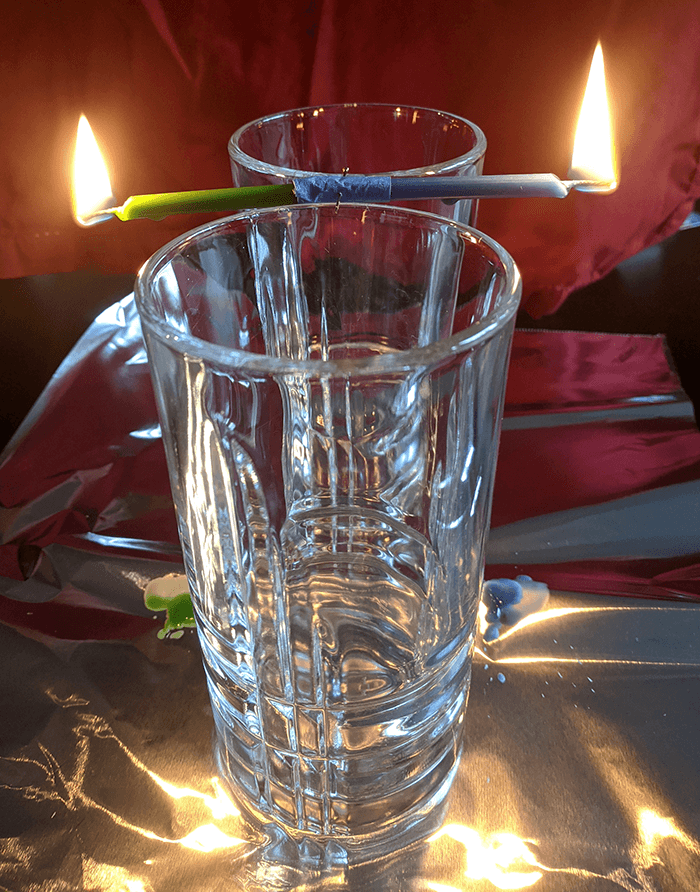Playing with Fire: Doing Fun Science at Home during School Closures (Activity #3)
Follow along with a Science Buddies parent who is using family STEM activities to keep her kids learning at home during the COVID-19 school shutdown. New posts every Monday, Wednesday, and Friday. Today's adventure... party trick meets science while exploring why perfectly balanced birthday candles act like a seesaw when lit.

A hand holding a lit match to light candles that are part of a candle seesaw physics science activity.
Playing with Fire is Bad... or is It?
Don't play with fire. I've certainly told my kids that! On the other hand, let's admit that there is something truly fascinating about fire. Why else would we love birthday candles and campfires so much? (Besides the cake and s'mores parts, of course.)
The opportunity to experiment safely with fire is a pretty cool experience for kids. What does safely mean when it comes to a fire science activity? You may have additional rules to add, but here are my basic four:
- A responsible adult must be supervising.
- Keep all your "parts" away from the fire, including tying back long hair, tucking in billowy clothes, and rolling up long sleeves.
- Work on a nonflammable surface.
- Just in case things go wrong, keep something to put out flames handy like a bucket of water, a fire blanket, or a fire extinguisher.
With those safety rules in place, there's no reason you and your kids can't do some fun and safe fire-based experiments at home. Here are a few options:
- Make a Candle Flame Jump: investigate how a flame can jump from one candle to another.
- A Candle Seesaw Balancing Act: use candles to investigate the balancing forces of a seesaw.
- Discover the Flaming Colors of Fireworks: discover how fireworks get their colors.
- Make a Fire Snake: try growing a large black 'snake.'
My Pick of the Day: Candle Seesaw
These days of school closure are long. We're only on our second week, and already, things feel exhausting and chaotic juggling work-at-home and kids-at-home schedules. Some days, my plans to do science activities with the kids get pushed aside. But I keep hands-on science in mind and am ready to pull it out when needed. Even at the end of a long day, science can inspire kids. That's how I ended up doing the A Candle Seesaw Balancing Act activity with my kids.
I had planned to do it at some point. It uses birthday candles, which I knew we had in a drawer, so I figured it would be an easy pick. Plus, it involves fire. It was just what we needed.
It was the end of a long day of work and school from home. My husband was making dinner. My middle schooler had had enough of the rest of us and holed up in his room. My second-grader asked (again) for more TV time. I said no and immediately realized I'd need to fill the TV-void with something else. Do you know how big a TV-void is? It requires serious entertainment, which is how we ended up covering the table in aluminum foil, grabbing some drinking glasses and a box of matches, and taping birthday candles together (end to end).


Once the candles were taped together and carefully balanced on the glasses, I asked my second-grader what she expected to happen when we lit them. She had some interesting answers — not correct ones, but fun ones all the same. After rolling up some bulky sleeves, we lit the candles (the part she was most looking forward to), and she was amazed to see the candles see-saw back and forth as the candles burned.

(Note: in the image above, the lit candles appear almost balanced. As they burn, the balance changes as the candles seesaw up and down, which is what makes this activity fun to do and mesmerizing to watch. You'll have to try it to see it in action!)
We talked about why and how it happens for a good 10 minutes after the seesawing began. Then, eager to share, she ran upstairs and barged into her brother's room demanding that he try it, too. Let's just say he came downstairs under duress. A few minutes later, his grumpy look was gone though, and he was just as intrigued by the seesawing of the candles.
If you're looking to fill a TV-void, or any other void on these crazy coronavirus days, I invite you to start your own science at home adventure. If you do, or if you have questions or comments, drop me an email. I would love to hear what you have planned and what fun science you try at home with your kids.
If you want to see how my science at home adventure started, check out the first post. And if this blog post was useful to you, please share it with other parents.
View All Posts in this Series
- Activity 1 - Getting Started and Hand Washing
- Activity 2 - Taking Flight with Kites
- Activity 3 - Candle Seesaw and Fire Science
- Activity 4 - Dissecting Flowers
- Activity 5 - Building a Toy Parachute
- Activity 6 - Paper Marbling
- Activity 7 - Shaping Hard-boiled Eggs
- Activity 8 - Invisible Ink
- Activity 9 - Robot Hand
- Activity 10 - Plastic Egg Rockets
- Activity 11 - Rubber Band Guitar
- Activity 12 - Making Model Viruses
- Activity 13 - Air Cannons
- Activity 14 - Balancing an Art Mobile
- Activity 15 - Gumdrop Geometry
- Activity 16 - Solar Updraft Tower
- Activity 17 - Cotton Ball Launcher
- Activity 18 - Wire Water Striders
- Activity 19 - Ice Cream in a Bag
- Activity 20 - Wind-powered Sail Cars
- Activity 21 - Curling Metal
- Activity 22 - Popsicle Stick Catapult
- Activity 23 - Candy Diffusion
- Activity 24 - STEM Videos
- Activity 25 - Making Slime
- Activity 26 - Straw Siphon
- Activity 27 - Elephant Toothpaste
- Activity 28 - Balloon Hovercraft
- Activity 29 - Aluminum Foil Boats
- Activity 30 - Wall Marble Run
A science activity log is available as a Word document or as a Google doc for online convenience. (Just choose "File/Make a copy" to save it to your Google Drive.)
About the Author
Sandra, Science Buddies' Vice President of STEM education, holds a PhD in Genetics from Stanford University and has spent the last twelve years working on science education and STEM outreach. Right now, she's stuck working from her home in the Pacific Northwest with her husband, second grader, middle schooler, and two oddly noisy gerbils. She hypothesizes her sanity will hold as long as she gets a daily dose of sunshine.
Categories:
You Might Also Enjoy These Related Posts:
- Wall Marble Run: Doing Fun Science at Home during School Closures (Activity #30)
- Aluminum Foil Boats: Doing Fun Science at Home during School Closures (Activity #29)
- Hovercraft: Doing Fun Science at Home during School Closures (Activity #28)
- Elephant Toothpaste: Doing Fun Science at Home during School Closures (Activity #27)
- Straw Siphon: Doing Fun Science at Home during School Closures (Activity #26)
- Slime Three Ways: Doing Fun Science at Home during School Closures (Activity #25)
- A STEM Videos Breather: Doing Fun Science at Home during School Closures (Activity #24)
- Candy Experiments: Doing Fun Science at Home during School Closures (Activity #23)










